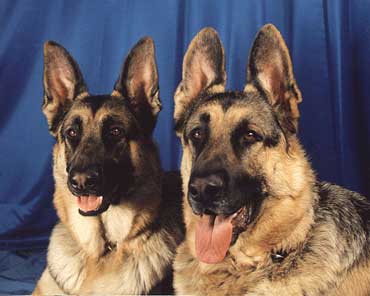As you edit for grammar, you’ll be more successful if you try not to look for everything simultaneously. In the next two sections, you’ll focus on subject-verb agreement. A big part of grammar is matching up the subject with the verb. Subjects and verbs must agree in number. Singular subjects need singular verbs; plural subjects require plural verbs. In the present tense, singular verbs end in the suffix -s or -es; plural verbs do not.

Source: German Shepherd Dog black and red, Judy N, Wikimedia
A German Sheperd sits proudly.

Source: German Shepherd Dogs portrait, jn2race, Wikimedia
Two German Shepherds sit proudly.
When the subject and verb follow closely, your “grammar phone” might suffice for editing, but when you write more complex sentence structures, agreement between the subject and verb requires closer attention. For example, when two singular nouns are joined by “and,“ the subject is plural and requires a plural verb.
The younger German Shepherd and her mother sit proudly.
However, when two singular nouns are joined by “or,” the subject is singular and requires a singular verb.
Either the younger German Shepherd or her mother sits still.
Subject-verb agreement gets a little trickier when indefinite pronouns are the subjects. When you use the pronouns he or she, you’re referring to a specific person. It also refers to a specific thing. When you use an indefinite pronoun, though, you’re referring to a nonspecific person, place, or thing, i.e., “Somebody should do something.”
Review the following information about indefinite pronouns:
- Indefinite pronouns that end in -one are always singular.
- Indefinite pronouns that end in -body are always singular.
- The indefinite pronouns both, few, many, others, and several are always plural.
- The indefinite pronouns all, any, more, most, none, and some can be singular or plural, depending on how they are used.
| Indefinite Pronouns | ||
|---|---|---|
| Singular | Plural | Singular or Plural |
| another | both | all |
| anyone | few | any |
| each | many | more |
| everyone | others | most |
| everybody | several | none |
| everything | some | |
| much | ||
| nobody | ||
| nothing | ||
| other | ||
| someone | ||
| anybody | ||
| anything | ||
| either | ||
| one | ||
| neither | ||
| no one | ||
| somebody | ||
| something | ||

Source: Zoo Statue - St. Louis Zoo, Tojosan, Flikr
That both and several are plural makes sense, but it’s more difficult to grasp that everyone, everybody, and everything are singular until you test one with your “grammar phone.”
Which would you say?
Everybody are going to the zoo.
Everybody is going to the zoo.
What about the group of indefinite pronouns that includes all, any, more, most, none, and some, which can be singular and plural? How do you decide what verb to use? If the indefinite pronoun means “one” in the sentence, it’s singular. If the pronoun refers to more than one, it’s plural.
Let’s look at some examples.
None of the tourists want to visit the giraffes. (None is plural and means “not any” in this sentence, so you need a plural verb, “want.”)
None of the giraffes that escaped from the refuge was ever returned. (None is singular and means “not one” in this case, so you need a singular verb, “was.”)

Continue practicing with these items. Refer back to the “Indefinite Pronoun” chart as needed. For each sentence below, choose the correct verb. Click in the appropriate box to record your answer.
- Many of the students ______ after school.
- Each of the vocalists _____ the high notes.
- Both of the girls _____ pierced ears.
- Either Sam or Abe _____ the giraffe food on the truck.
- Everything ______ in your final grade.